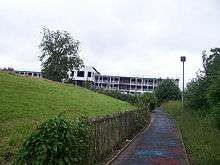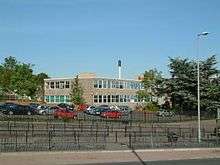Trinity High School (Rutherglen)
| Trinity High School | |
|---|---|
|
"Home, school, church, stronger together" | |
| Address | |
|
Rutherglen G73 Glasgow | |
| Information | |
| Type | Roman Catholic |
| Established | Circa 1971 |
| Headmaster | Peter Bollen |
| Scottish Highers | 1st Years – 6th Years |
| Gender | Mixed |
| Enrollment | 983 |
| Colour(s) | |
| Website | Trinity High School |
Trinity High School is a Roman Catholic secondary school, currently, located in Rutherglen, Scotland near the city of Glasgow. It was established in 1971. The current Head Teacher is Peter Bollen who took office between 2007 and 2008 with incumbent Patricia Rossi leaving her post. The school uses a traditional house system.
The pupils are organised into one of three guidance houses, formerly having been four. The three houses are Iona, Dunkeld and Melrose. Jedburgh was previously a house but was removed during re-organisation of the school faculty. The school was victim to an arson attack which contributed to its demolishment in 2007. The new school was completed in 2009, in the former Glenside Drive where the old Trinity building was situated. Pupils then returned after the summer of 2009, starting in August. The school hosts many afterschool clubs and has competed in national competitions. Around mid-October an awards ceremony is held to honour pupils who have achieved academically and through sports activities. Although a Catholic school, it accepts students from other religious denominations.
History
According to their website Trinity's history starts from the early 1970s. Apparently there was a growing demand for a school to accommodate students from around the South Lanarkshire. Their website details:
The first Trinity High School was situated in the former Gateside School building in Hamilton Road Cambuslang. The building is now functioning as part of Cambuslang College. The first pupils started attending the school in 1970. Prior to the opening of Trinity High School, pupils travelled to St Bride's in East Kilbride or to St Columbkille's Junior Secondary School in Rutherglen.The growing demand for pupils to attend Trinity High School in the early years saw a growing dissatisfaction by parents at the lack of facilities in the school. This was partly due to the erection of temporary accommodation in what was previously the school playground. Parental protests at the lack of facilities, coupled with issues over staffing due to industrial action, saw tenders for building a new Trinity school issued in October 1974.
Throughout this difficult time Trinity pupils continued to contribute to the local community in a very positive way. In July 1975 the Rutherglen Reformer carried an article reporting that Trinity High School raised over £3000 for various charities, an admirable tradition carried on in Trinity to this day. The figure raised by the pupils is even more impressive when you consider the prices of groceries at that time. For example, an E3 size packet of Ariel soap powder cost 44p whilst 20 cigarettes cost a mere 46p!
Lanark Council accepted a tender of £1,750,000 for the school to be built on its current site by the firm of Andrew Crouch & Sons Ltd? an English firm with offices in Glasgow. The building process was not without its difficulties, particularly when a young labourer unearthed a skeleton, believed to be that of a former owner of the house on which the school is built. A further problem occurred when an inquisitive young boy entered the building site and fell down a well breaking his leg. Fortunately, the night watchmen heard his cries and he was quickly taken to hospital. The school was completed in time for the new intake of pupils starting on August 19th 1977. It was built to accommodate 1000 pupils and the Headteacher was Mr Thomas Curran. The ‘old’ Trinity at Hamilton Road continued to be used for First and Second year pupils, with senior pupils attending the new Trinity.
The school is not, as suggested by local legend, built the wrong way round. According to Alex Moyes, a surveyor working on the project, the school was built this way in order that the main entrance had nicer views of the valley! The school also opted for a theatre rather than an assembly hall, believing that it would be of greater benefit to the community. Another extra in the school was the "animal room" which I believe was to be used for producing specimens for Biology lessons. This was, very quickly, halted by the council and the room is now being used for a variety of purposes by the school's Science Technicians.[1]

On the 5th of November 2007 the former school building in Glenside Drive, now demolished as part of the "Schools Modernisation Programme", was set ablaze.[2][3] Before it was set on fire it was due to be destroyed by contractors InspirdED who the council passed responsibility onto.[3][4][5]
A fire had broken out in the school on Guy Fawkes Night. A total of eight firefighter crews, 60 firefighters in total, worked in the night to control the blaze and by 1:00 AM on Monday morning the fire was finally extinguished. On Bonfire night there were several incidents throughout Scotland in the aftermath of the festival that sparked fires similar to the Trinity School blaze as evidenced by the Strathclyde Fire and Police services, and in addition this gained widespread media attention.[3][4]
Hamilton

Pupils at Trinity High School were temporarily located at the Holy Cross High School building. The building comprises several departments located on several different sites around the grounds.
The English, Drama, Religious Education and Music departments are at the forefront on the main entrance (north of the school gates). The building also accommodates a large gym hall and library. Slightly north-east from the gates is the Administration building (the reception area where visitors must report). The Administration building is where the Head Teacher's office and his staff's offices are located. Behind this building is the Physical Education departments. Two gym halls are in this building.
To the east of the gates entrance is a car park and further along the science building is visible. Chemistry, Biology, Physics, Information Systems, Administration, Accounting, IT, and the Computing Science departments are located here. North-west from the science building is the Craft & Design, Engineering workshop departments. To the west of the science building is the Home Economics, Technological studies, Art & Design, departments and some several Craft & Design rooms. Further west from the science building is where the Modern Studies, Mathematics, History and Geography departments situate. On the ground floor are the 5th and 6th year Common Rooms and two canteens. This building appears larger than the forefront building. On Thursday, February 5 the school was closed due to a power failure.
References
- ↑ "School History". Trinity High School. Retrieved 31 January 2009.
- ↑ "Scotland's Largest Schools PFI" (PDF). Marc Roca. Retrieved 30 January 2009.
- 1 2 3 "BONFIRE NIGHT BLAZE DESTROYS TRINITY SCHOOL". Douglas Dickie. The Rutherglen Reformer. 8 November 2007. Retrieved 29 January 2009.
- 1 2 "Crews record busy Bonfire Night". BBC News. 6 November 2007. Retrieved 29 January 2009.
- ↑ "South Lanarkshire Schools PPP Programme". Architecture + Design Scotland, ads.org.uk. 24 May 2005. Retrieved 29 January 2009.
External links
- Trinity High School website
- Council information about the school
- Proposal to realign the school catchment areas of both Cathkin and Trinity High Schools and St Cadoc
- June 2006 School Inspection Report
- Scbool profile at Education Scotland website
- Report of the £290 million project "School Modernisation Programme"
